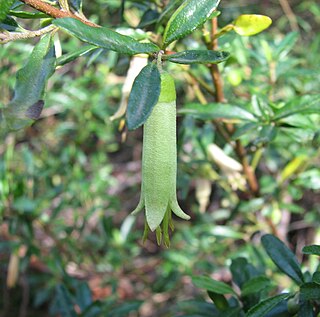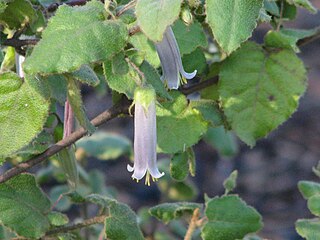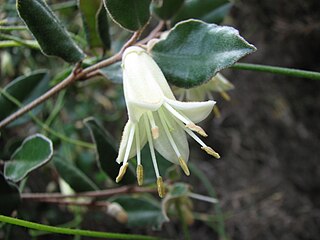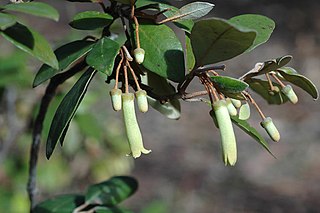
Correa lawrenceana, commonly known as mountain correa, is a species of shrub or small tree of the family Rutaceae and is endemic to Australia. It has elliptical to egg-shaped leaves arranged in opposite pairs and cylindrical, greenish yellow to red flowers usually arranged singly or in groups of up to seven in leaf axils with the stamens protruding beyond the end of the corolla.

Correa calycina, commonly known as the South Australian green correa or Hindmarsh correa, is a species of tall, dense shrub that is endemic to a small area of South Australia. It has papery, oblong leaves and pendulous green flowers arranged singly on the ends of short side branches.

Correa glabra, commonly known as the rock correa, is a species of tall, erect shrub that is endemic to Australia. It usually has elliptical, mostly glabrous leaves and pendent, pale green to pale yellow flowers arranged singly on short side shoots.

Correa aemula, commonly known as the hairy correa, is a species of shrub that is endemic to south-eastern Australia. It has broadly heart-shaped leaves arranged in opposite pairs, green or greyish green, pendent flowers arranged singly or in pairs and ageing to mauve-purple.

Correa backhouseana is a species of rounded shrub that is endemic to coastal and near-coastal areas of southern Australia. It has elliptical to egg-shaped or round leaves that are densely hairy on the lower surface, and cylindrical to funnel-shaped, cream-coloured to pale green or red and yellow flowers.

Correa decumbens, commonly known as the spreading correa, is a species of prostrate to spreading shrub that is endemic to South Australia. It has narrow oblong to narrow elliptical leaves and narrow cylindrical, pink to red flowers with green lobes.

Correa pulchella, commonly known as the salmon correa, is a species of small prostrate to erect shrub that is endemic to South Australia. It has glabrous, leathery, narrow oblong to broadly egg-shaped leaves and pendulous, cylindrical, pink to red or orange flowers arranged singly on short side branches.
Correa eburnea, commonly known as the Deep Creek correa, is a species of shrub that is endemic to the Fleurieu Peninsula in South Australia. It has papery, elliptic to egg-shaped leaves, and up to five green, nodding flowers arranged in leaf axils.

Isopogon fletcheri, commonly known as Fletcher's drumsticks, is a species of plant in the family Proteaceae and is endemic to a restricted area in the Blue Mountains of New South Wales. It is a bushy shrub with narrow egg-shaped to narrow lance-shaped leaves with the narrower end towards the base, and top-shaped to egg-shaped heads of yellowish or creamy green flowers.

Hakea trineura is a shrub of the family Proteaceae and is endemic to Queensland Australia. It has large pendulous greenish-yellow flowers from May to September.

Persoonia brevifolia is a plant in the family Proteaceae and is endemic to a restricted area near the border between south-eastern New South Wales and Victoria. It is an erect shrub with elliptic to egg-shaped leaves and cylindrical yellow flowers arranged singly in leaf axils.

Boronia repanda, commonly known as the granite rose, repand boronia or border boronia, is a plant in the citrus family Rutaceae and is endemic to an area near the eastern border between New South Wales and Queensland in Australia. It is a small erect, woody shrub with many branches, thick warty, oblong leaves and pink, rarely white flowers arranged singly in leaf axils.

Boronia adamsiana, commonly known as Barbalin boronia, is a plant in the citrus family, Rutaceae and is endemic to a small area in the south-west of Western Australia. It is an erect, hairy shrub with trifoliate leaves and pink or white, four-petalled flowers.

Correa lawrenceana var. cordifolia, commonly known as the pink mountain-correa, is a variety of Correa lawrenceana and is endemic to south-eastern Australia. It is a shrub with leathery, broadly egg-shaped to heart-shaped leaves, and pink flowers with yellowish tips arranged singly or in groups of two or three in leaf axils.
Correa lawrenceana var. genoensis, commonly known as the Genoa River correa, is a variety of Correa lawrenceana and is endemic to south-eastern Australia. It is a shrub with egg-shaped leaves and yellowish green flowers usually arranged singly in leaf axils.

Correa lawrenceana var. glandulifera, commonly known as the mountain correa, is a variety of Correa lawrenceana and is endemic to eastern Australia. It is a shrub or small tree with egg-shaped leaves and greenish yellow flowers arranged singly or in groups of up to five with woolly hairs on the outside.

Correa lawrenceana var. latrobeana is a variety of Correa lawrenceana that is endemic to south-eastern Australia. It is a shrub or small tree with elliptical to egg-shaped leaves and cylindrical, greenish-yellow or reddish-mauve flowers arranged singly or in groups of up to seven in leaf axils or on the ends of branchlets.
Correa lawrenceana var. macrocalyx is a variety of Correa lawrenceana and is endemic to New South Wales. It is a shrub with leathery, egg-shaped to broadly egg-shaped leaves, and cylindrical, greenish yellow flowers arranged in leaf axils or on the ends of short branchlets.

Prostanthera densa, commonly known as villous mint-bush, is a species of flowering plant in the family Lamiaceae and is endemic to near-coastal areas of New South Wales. It is an erect, often compact shrub with aromatic branches, egg-shaped leaves, and mauve flowers with orange markings inside.

Goodenia heteromera, commonly known as spreading goodenia or fan flower, is a species of flowering plant in the family Goodeniaceae and is endemic to south-eastern Australia. It is a perennial or annual, stolon-forming herb with lance-shaped to egg-shaped leaves with the narrow end towards the base, and racemes of yellow flowers with brownish markings.


















